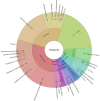Environmental Factors Shaping the Diversity and Spatial-Temporal Distribution of Indoor and Outdoor Culturable Airborne Fungal Communities in Tianjin University Campus, Tianjin, China
- PMID: 35774467
- PMCID: PMC9237511
- DOI: 10.3389/fmicb.2022.928921
Environmental Factors Shaping the Diversity and Spatial-Temporal Distribution of Indoor and Outdoor Culturable Airborne Fungal Communities in Tianjin University Campus, Tianjin, China
Abstract
Airborne fungi have significant influence on air quality and may pose adverse effects on human health due to their allergenic and pathogenic effect. We carried out a 1-year survey on the airborne fungal diversity and concentration of indoor and outdoor environments, within the Tianjin University campus. Airborne fungi were sampled using an HAS-100B air sampler. Isolated fungal strains were identified based on morphological and molecular analysis. A total of 641 fungal strains belonging to 173 species and 74 genera were identified in this study. The dominant fungal genera were Cladosporium (29.49%), Alternaria (25.9%), and Epicoccum (6.24%), while the most frequently occurring species were A. alternata (15.44%), C. cladosporioides (11.86%), and E. nigrum (5.77%). The mean fungal concentration at different sites ranged from 0 to 420 CFU/m3, which is lower than the permissive standard level. There was a seasonal variation in the airborne fungal community, while temperature and relative humidity were positively correlated with the fungal concentration and diversity at almost all the sites. Higher fungal diversity was recorded in peak period of human traffic at the two canteens, whereas the two dormitories showed higher fungal diversity in off-peak period. Our study provides the first report on the diversity and concentration of airborne fungal species within different Tianjin University campus environments and clarifies the role played by environmental factors on the analyzed fungal community. Our results may represent valuable information for air quality monitoring and microbial pollution control in densely populated human living environments.
Keywords: ITS sequencing; airborne fungi; concentration; environmental factors; fungal diversity and community structure; indoor; morphology; outdoor.
Copyright © 2022 Yuan, Wang and Pecoraro.
Conflict of interest statement
The authors declare that the research was conducted in the absence of any commercial or financial relationships that could be construed as a potential conflict of interest.
Figures












Similar articles
-
A review of pathogenic airborne fungi and bacteria: unveiling occurrence, sources, and profound human health implication.Front Microbiol. 2024 Sep 19;15:1428415. doi: 10.3389/fmicb.2024.1428415. eCollection 2024. Front Microbiol. 2024. PMID: 39364169 Free PMC article. Review.
-
Environmental Factors Affecting Diversity, Structure, and Temporal Variation of Airborne Fungal Communities in a Research and Teaching Building of Tianjin University, China.J Fungi (Basel). 2022 Apr 22;8(5):431. doi: 10.3390/jof8050431. J Fungi (Basel). 2022. PMID: 35628687 Free PMC article.
-
Seasonal variation of airborne fungal diversity and community structure in urban outdoor environments in Tianjin, China.Front Microbiol. 2023 Jan 9;13:1043224. doi: 10.3389/fmicb.2022.1043224. eCollection 2022. Front Microbiol. 2023. PMID: 36699604 Free PMC article.
-
Analysis of culturable airborne fungi in outdoor environments in Tianjin, China.BMC Microbiol. 2021 May 2;21(1):134. doi: 10.1186/s12866-021-02205-2. BMC Microbiol. 2021. PMID: 33932997 Free PMC article.
-
Transmission of Airborne Bacteria across Built Environments and Its Measurement Standards: A Review.Front Microbiol. 2017 Nov 29;8:2336. doi: 10.3389/fmicb.2017.02336. eCollection 2017. Front Microbiol. 2017. PMID: 29238327 Free PMC article. Review.
Cited by
-
Fungal Infections in Kidney Transplant Recipients: A Comprehensive Narrative Review.Microorganisms. 2025 Jan 18;13(1):207. doi: 10.3390/microorganisms13010207. Microorganisms. 2025. PMID: 39858974 Free PMC article. Review.
-
Epidemiology, Clinical Manifestations, and Outcome of Mucormycosis in Solid Organ Transplant Recipients: A Systematic Review of Reported Cases.Open Forum Infect Dis. 2024 Jan 30;11(6):ofae043. doi: 10.1093/ofid/ofae043. eCollection 2024 Jun. Open Forum Infect Dis. 2024. PMID: 38887489 Free PMC article. Review.
-
A review of pathogenic airborne fungi and bacteria: unveiling occurrence, sources, and profound human health implication.Front Microbiol. 2024 Sep 19;15:1428415. doi: 10.3389/fmicb.2024.1428415. eCollection 2024. Front Microbiol. 2024. PMID: 39364169 Free PMC article. Review.
-
Bioaerosol assessment in indoor and outdoor environments: a case study from India.Sci Rep. 2023 Oct 23;13(1):18066. doi: 10.1038/s41598-023-44315-z. Sci Rep. 2023. PMID: 37872255 Free PMC article.
-
Hospital distribution, seasonality, time trends and antifungal susceptibility profiles of all Aspergillus species isolated from clinical samples from 2015 to 2022 in a tertiary care hospital.BMC Microbiol. 2024 Apr 3;24(1):111. doi: 10.1186/s12866-024-03267-8. BMC Microbiol. 2024. PMID: 38570761 Free PMC article.
References
-
- Abdel Hameed A. A., Khoder M. I., Yuosra S., Osman A. M., Ghanem S. (2009). Diurnal distribution of airborne bacteria and fungi in the atmosphere of Helwan area. Egypt. Sci. Total Environ. 407 6217–6222. - PubMed
-
- Banerjee U. C., Weber P., Ruffin J., Banerjee S. (1987). Airborne Fungi Survey of Some Residences in Durham. North Carolina U. S. A. Grana. 26 103–108. 10.1080/00173138709428910 - DOI
LinkOut - more resources
Full Text Sources

